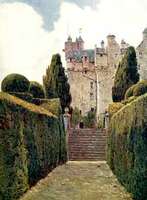So it was in the wood of young seedling trees, where Oak and Holly, Birch, Beech and Mountain Ash, came up together in a close thicket of young saplings. It seemed well to consider, in the first place, how to bring something like order into the mixed jumble, and, the better to do this, to appeal to the little trees themselves and see what they had to say about it.
The ground runs on a natural slope downward to the north, or, to be more exact, as the highest point is at one corner, its surface is tilted diagonally all over. So, beginning at the lower end of the woody growth, near the place where the house some day might stand, the first thing that appeared was a well-grown Holly, and rather near it, another; both older trees than the more recent seedling growth. Close to the second Holly was a young Birch, the trunk about four inches thick and already in the early pride of its silvering bark. That was enough to prompt the decision that this part of the wood should be of silver Birch and Holly, so nearly all other growths were cut down or pulled up. A hundred yards higher up there were some strong young Oaks, then some Beeches, and all over the top of the ground a thick growth of young Scotch Fir, while the western region had a good sprinkling of promising Spanish Chestnut.
All these natural groupings were accepted, and a first thinning was made of the smallest stuff of other kinds. But it was done with the most careful watching, for there were to be no harsh frontiers. One kind of tree was to join hands with the next, though often a distinct deviation was made to the general rule. For the beautiful growth of the future wood was the thing that mattered, rather than obedience to any inflexible law.

